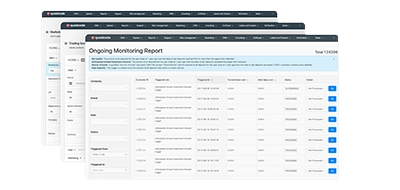Back
Contents
Что такое рыночный ордер?

Demetris Makrides
Senior Business Development Manager

Iva Kalatozishvili
Business Development Manager
По сути, рыночный ордер — это простой торговый приказ, который предписывает брокеру или бирже купить или продать актив как можно быстрее по лучшей текущей цене. Рыночные ордера исполняются быстро и легко, что понятно и ценно для трейдеров. Однако он не даёт контроля над точной ценой, по которой будет совершена сделка.
Как работает рыночный ордер
Когда вы решаете исполнить рыночный ордер, он исполняется в режиме реального времени по текущей рыночной цене, без каких-либо задержек и колебаний. На волатильных или непредсказуемых рынках, где скорость важнее точности цены, окончательная цена исполнения может колебаться.
Исполнение рыночного ордера подразумевает, например, покупку акций компании по максимально возможной цене. Однако, если вы решите продать свои акции, рыночный ордер будет учитывать максимальную цену, которую другой покупатель готов заплатить прямо сейчас, и продаст ваши акции по этой цене.
На рынках с высокой ликвидностью и большим количеством покупателей и продавцов, присутствующих одновременно, рыночный ордер обычно исполняется по цене, близкой к последней цене, по которой была совершена предыдущая сделка. Цена исполнения вашего ордера может значительно отличаться от отображаемой цены при размещении ордера на рынках с высокой ликвидностью. Это отклонение называется «проскальзыванием» и может иногда приводить к ухудшению торговых результатов, особенно в условиях нестабильных рыночных условий.
Когда использовать рыночный ордер
Рыночные ордера хорошо работают, когда ваша главная цель — совершить сделку, не беспокоясь о точной цене сделки. Такой подход особенно удобен в ситуациях, описанных ниже.
Если вам необходимо открыть или закрыть позицию, или вы хотите немедленно войти в неё, например, из-за внезапных изменений рынка или выхода важных новостей, использование рыночного ордера гарантирует быстрое исполнение вашей сделки и мгновенный вход в рынок или выход из него. Это, пожалуй, самое большое преимущество рыночного ордера. В ситуации, когда акции быстро растут в цене благодаря публикации хорошего отчёта о прибылях, рыночный ордер позволяет вам выкупить акции и получить выгоду от восходящего тренда, прежде чем цены вырастут ещё больше.
Опасения и переживания по поводу упущенных торговых возможностей можно уменьшить, выбрав рыночный ордер вместо лимитного; это, по сути, гарантирует немедленное участие в торгах. В ситуациях, когда цены меняются быстро и непредсказуемо, лимитные ордера могут не быть исполнены, если рынок не достигнет указанного вами уровня. В результате лимитные ордера могут лишить вас возможности торговать. Размещая рыночный ордер, вы можете избежать этого риска, поскольку сделка будет совершена при условии наличия достаточной ликвидности и покупателей или продавцов.
На высоколиквидных рынках, таких как основные акции или Форекс, где объём торгов высок, а спреды между ценами спроса и предложения узкие, рыночные ордера, вероятно, будут исполняться по цене, близкой к текущей рыночной цене, что указывает на незначительную разницу между ценой, которую готов заплатить покупатель, и ценой, которую ожидает получить продавец. Это часто приводит к исполнению рыночных ордеров по ценам, очень близким к цене последней сделки, что снижает потенциальный эффект проскальзывания. Рыночные ордера считаются лучшим вариантом для трейдеров, которые стремятся быстро открывать и закрывать позиции и не беспокоятся о проскальзывании.
Недостатки использования рыночных ордеров
Использование рыночных ордеров для торговли обеспечивает быстрое и гарантированное исполнение, но также имеет недостатки на непредсказуемых или менее активных рынках. Отсутствие гибкости в ценообразовании является существенным недостатком. Нет никаких гарантий относительно точной цены, которую вы получите при размещении рыночного ордера; вместо этого вы обязуетесь торговать по текущей рыночной цене. Такая стратегия может привести к значительному проскальзыванию и непредвиденным последствиям на рынках, где цены могут быстро меняться в течение нескольких минут.
Если вы решили купить акции по рыночной цене, когда их цена быстро растет, а обработка заказа занимает некоторое время, прежде чем он будет исполнен, вам, возможно, придется заплатить большую сумму, чем вы изначально ожидали, из-за непрерывного роста цены в этот период.
Другим недостатком использования рыночных ордеров является возможность частичного исполнения ордеров на рынках с ограниченной ликвидностью. В ситуациях, когда по текущей цене недостаточно покупателей или продавцов для исполнения всего ордера, ваш ордер может обрабатываться по частям, при этом каждый сегмент может быть исполнен по разной цене. Такое фрагментированное исполнение может привести к увеличению торговых издержек и затруднить достижение вашей целевой средней цены. Когда вы решаете продать часть акций на рынке с низкой торговой активностью, используя рыночный ордер, часть ваших акций может быть продана по текущей цене спроса, в то время как оставшиеся акции могут быть проданы по более низким ценам, поскольку на рынке закончатся заинтересованные покупатели.
Более того, исполнение рыночных ордеров может представлять трудности, особенно при обработке крупных транзакций или в периоды волатильности рынка, когда условия неопределенны. В быстро меняющейся рыночной среде конечная цена исполнения сделки может значительно отклоняться от первоначального прогноза, что затрудняет стратегическое планирование торговли. Эта непредсказуемость может представлять проблему для трейдеров, которые в значительной степени зависят от конкретных точек входа и выхода для эффективного снижения рисков и достижения целей по прибыли. В связи с этим, несмотря на то, что рыночные ордера обеспечивают преимущество немедленного и гарантированного исполнения, они требуют тщательной оценки потенциальных рисков, особенно связанных с колебаниями цен и неполным исполнением.
Эффективные стратегии использования рыночных ордеров
При использовании рыночных ордеров в торговле важно учитывать некоторые практические аспекты, чтобы убедиться в их эффективности. Во-первых, перед размещением рыночного ордера критически важно оценить рыночные условия. Понимая волатильность и ликвидность рынка, вы можете оценить вероятность проскальзывания цены. Определите, соответствует ли рыночный ордер вашему торговому плану. Вероятность проскальзывания, или вероятность того, что ваш ордер будет исполнен по цене, значительно отличающейся от ожидаемой, выше на очень волатильных рынках, где цены быстро колеблются. Подумайте, может ли другой тип ордера предоставить вам больший контроль над ценой исполнения, чем рыночный ордер, в этой ситуации.
При торговле с рыночными ордерами, для более эффективного управления рисками, их полезно использовать вместе со стоп-лоссами. Стоп-лосс ордер запускает продажу ваших активов, как только рынок выходит за установленный вами уровень, что ограничивает потенциальные убытки. Используя рыночный ордер вместе со стоп-лоссом, вы можете гарантировать исполнение сделки и защитить её от существенных отрицательных колебаний цены.
Итог
Рыночный ордер — это фундаментальный торговый инструмент, обеспечивающий быстрое и надежное исполнение, что делает его идеальным для трейдеров, которым необходимо быстро действовать на рынке. Хотя он не обеспечивает такого же контроля цены, как лимитные ордера, его простота и эффективность делают его предпочтительным вариантом во многих торговых ситуациях. Мастерство заключается в знании правильного времени и метода эффективного применения рыночных ордеров, что позволяет трейдерам извлекать выгоду из рыночных колебаний, гарантируя быстрое исполнение сделок.
Обновлено:
19 декабря 2024 г.




